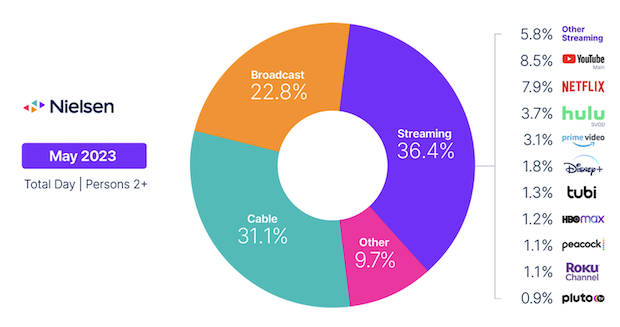After a 2.1% decline in April, streaming usage rebounded in May to 36.4% of TV time in the US. Although Nielsen made a change in methodology to better capture streaming usage that caused a monthly increase in viewership, about half of the 2.5% increase in monthly usage reflects viewer behavior . Despite streaming’s gains, however, total TV usage fell 4.4% from April.
Nielsen is steadily refining its measurement, so Roku is the latest service to gain standalone coverage in the gauge, capturing 1.1% of total TV usage in May. Roku’s stellar performance in May highlights the growing footprint of ad-supported free-to-air television services (FAST). Combined, the three independently reported FAST services (Pluto TV, Tubi TV, Roku Channel) are each comparable in usage to Peacock and HBO Max. And overall, they represent more audience than Amazon Prime Video. It was Tubi which garnered the largest audience in May (1.3%), ahead of Roku and Pluto TV (0.9%) which was therefore left behind by its two direct competitors FAST.
Netflix and Amazon Prime Video grew in May, posting usage increases of 9.2% and 5.1% respectively. Almost half of Netflix’s increase was due to the change in methodology, as well as the fact that the platform had the top three streaming titles this month: “Queen Charlotte: A Bridgerton Story” (5.4 billion minutes watched), “A Man Called Otto” (3.1 billion) and “The Mother” (3.0 billion). With 3.1% of television, Amazon Prime Video benefited from the strength of “The Marvelous Mrs. Maisel” and “Citadel,” which totaled 2.7 billion minutes of viewing. And for the fourth month in a row, YouTube maintained its position as the top platform, gaining 0.4 points of share to account for 8.5% of television.
The 4.4% decline in total television viewership in May was due to declines in viewership for broadcast and cable, which saw declines of 5.5% and 5.4% respectively. These declines led to a 0.3 point decline in market share for broadcast and cable. A 25% decline in sports viewership is largely responsible for declines in broadcasting.
But the most important thing remains the comparison with May 2022. Indeed, beyond the impact of the measurement deployed by Nielsen, we see how much the major aggregates have evolved, offering streaming a leading position in total audiences: cable fell from 36.5% to 31.1%, broadcasting from 24.4% to 22.8% and streaming from 31.9% to 36.4%. A streaming sector where leadership has been taken over by Youtube and where FAST services are beginning to seriously compete with paid SVOD services, suggesting a rapid change in the video subscription market in the coming months.

